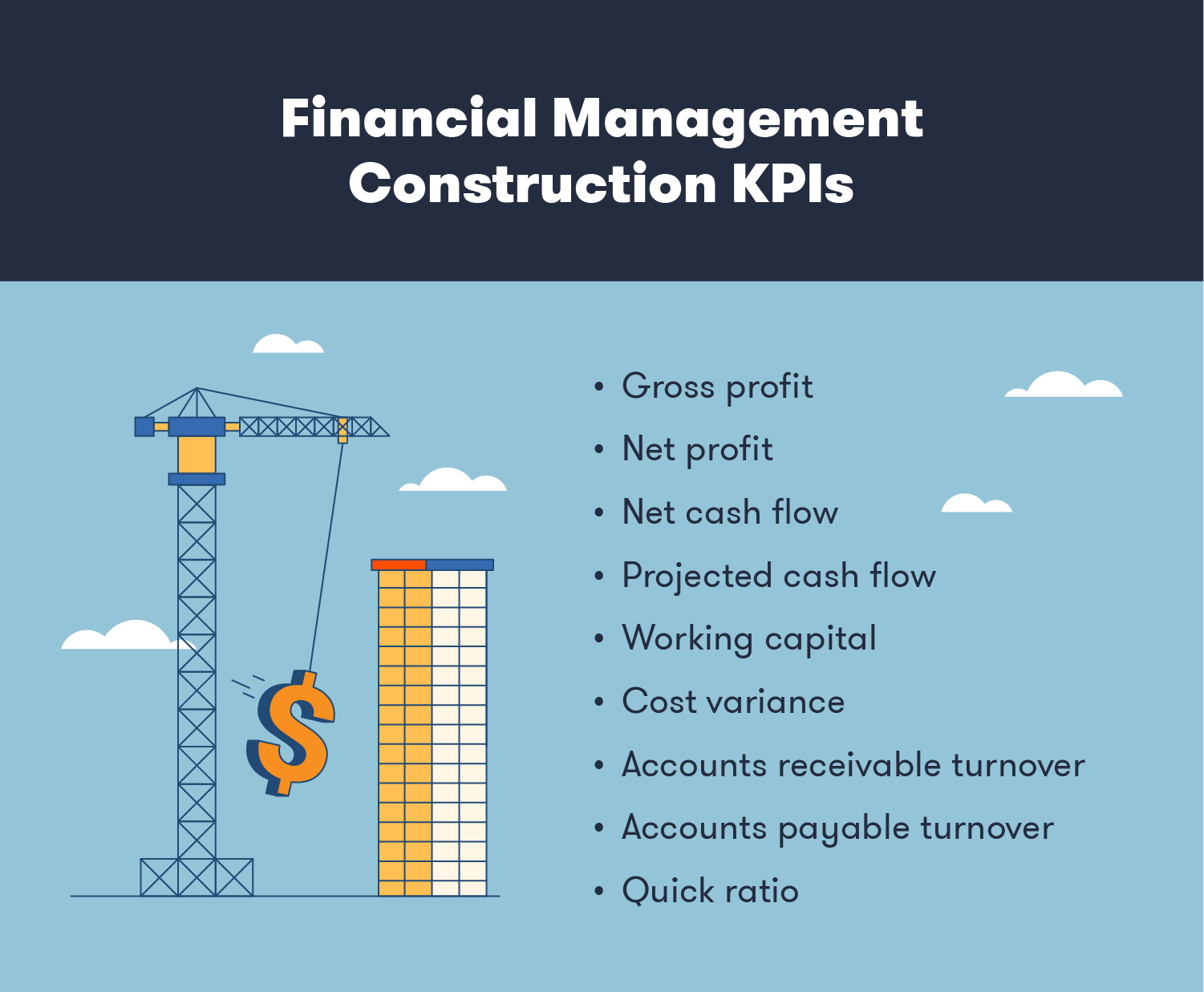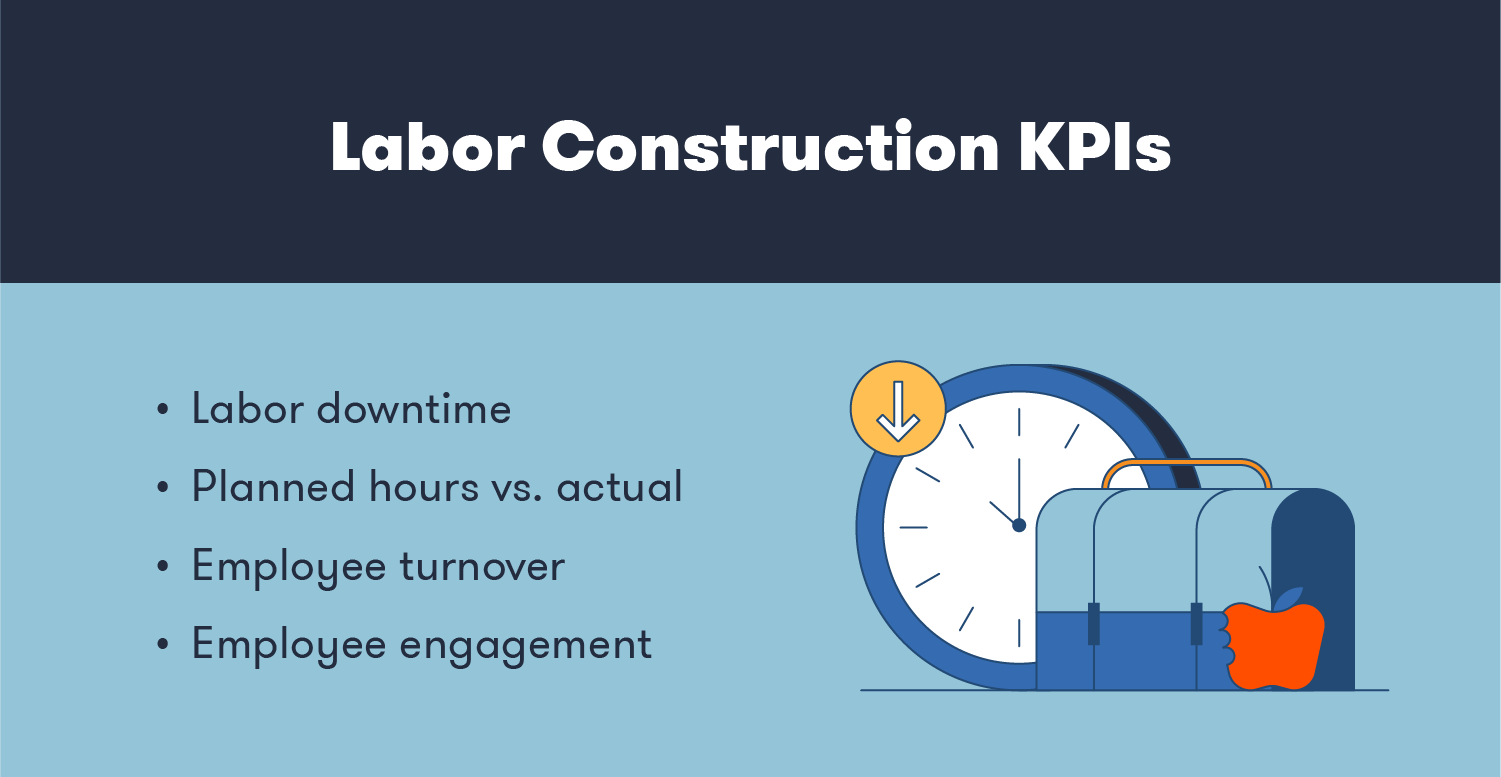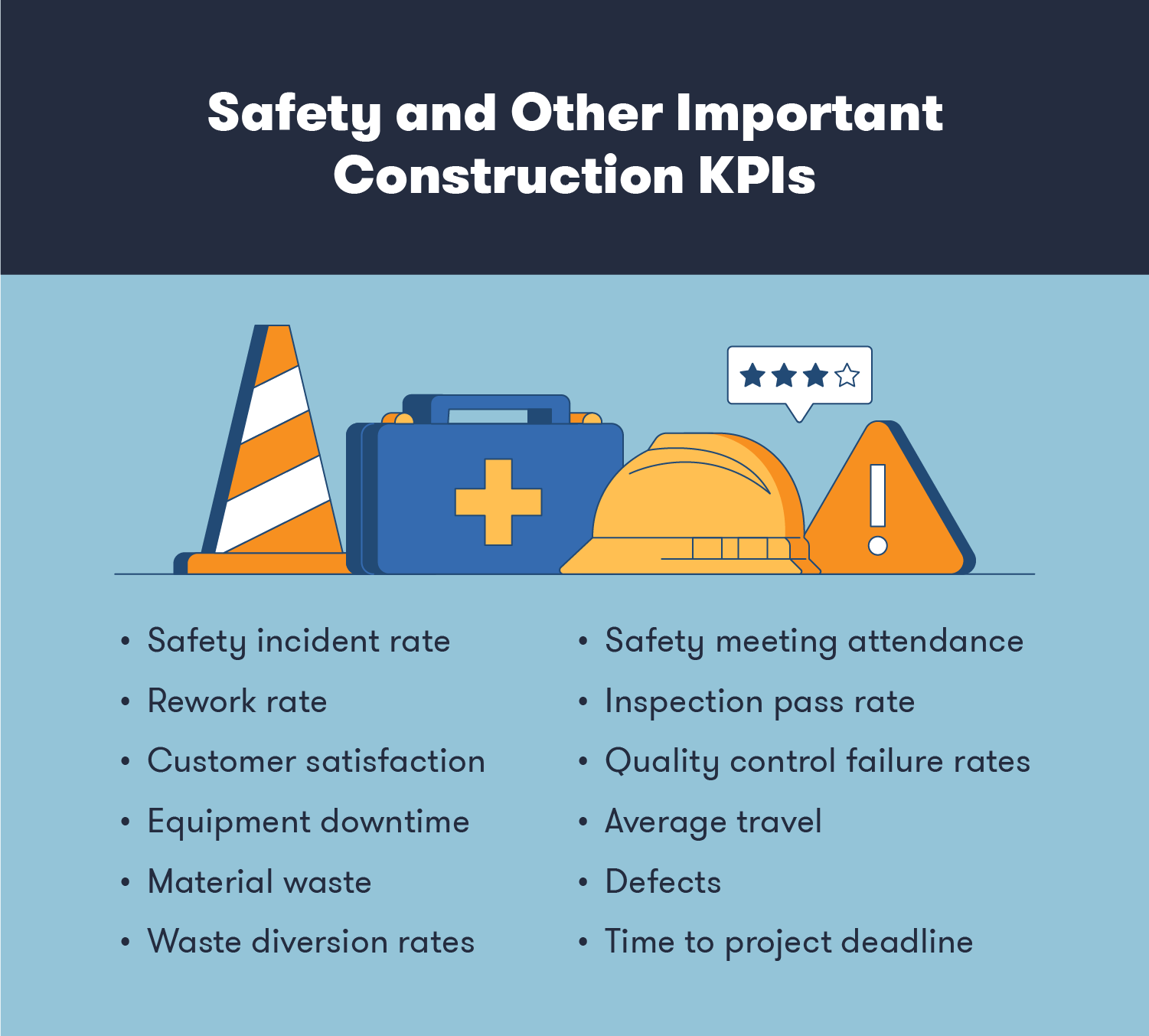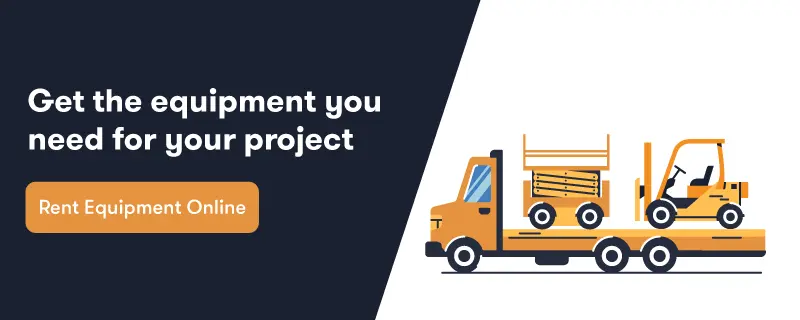Construction KPIs are a great tool for tracking the progress of a project and ensuring that metrics are met at every phase — from budgeting to customer satisfaction. Knowing what to track and how will set your projects up for success.
Construction key performance indicators (KPIs) are valuable in ensuring that all of the many phases of construction projects stay on track. The main objective of any construction project is to finish on time, within budget and with the best quality results possible. How you keep track of and measure those objectives is where construction KPIs come in.
What Are KPIs and Why Are They Important in Construction?
KPIs in construction are the tangible ways that a company can measure its success and keep track of objectives. They generally focus on factors such as budget and labor.

Tracking KPIs in construction can ensure that your projects stay on time and under budget while helping you monitor things like employee and client satisfaction, waste and safety. In general, they’re a great way to monitor business performance and determine growth opportunities. Here are the top construction KPIs that your business can start using today.
1. Gross Profit
Gross profit is the amount of money left after deducting the cost of goods (such as labor and materials) from net revenue, or sales. That number is then divided by the net revenue to give the gross profit margin, expressed as a percentage.
(Net sales – Cost of goods sold) ÷ Sales = Gross Profit
Gross profit is important to track because it can help with planning and budgeting for the remainder of the project, as well as for future projects.
Good to Know: The larger the gross profit and gross profit margin, the better. This metric is a good indication of how efficiently a business sells its products and services.
2. Net Profit
Net profit is the amount of money earned after deducting all expenses, including taxes and interest. Similar to gross profit, that number is then divided by the net sales to give the net profit margin, which is expressed as a percentage.
(Gross Profit – Operating costs – Taxes – Interest) ÷ Net Sales = Net Profit
Good to Know: The higher the net profit, the better a business is doing financially. A higher number will allow for more money to be reinvested back into the business. If this number is low, costs may need to be re-evaluated and prices potentially raised.
3. Net Cash Flow
Net cash flow describes the amount of money coming in and out of a business during a given period. It essentially calculates how much money a project gained or lost in a given period.
Cash inflow – Cash outflow = Net cash flow
Good to Know: If net cash flow is negative, the project is costing more money than it’s bringing in, and the business should consider improving collection procedures. If expected, poor cash flow isn’t always a cause for concern, such as during a period of high growth.
4. Projected Cash Flow
Projected cash flow predicts the amount of money coming in and out of the business for the next several months or even years. Also called a cash flow forecast, projected cash flow is calculated by predicting the amount of cash incoming and outgoing for a period and using a similar formula to the one above.
Predicted Cash Inflow – Predicted Cash Outflow = Projected Cash Flow
Utilizing projected cash flow as one of your construction KPIs is an ideal way to incentivize better planning, as it requires thinking about future projects and expenses.
Good to Know: Projected cash flow allows organizations to track potential expenses and make adjustments to increase potential earnings.

5. Working Capital
The measurement of a company’s assets against its liabilities is its working capital. The number indicates the ability to pay for short-term financial obligations.
Current assets – Current liabilities = Working capital
Assets include current inventory, cash and upcoming client payments. Liabilities are things such as debts owed.
Good to Know: The higher the number, the better the company’s financial health. If the number is negative, the company doesn’t have enough money to pay its current bills and needs to remedy this immediately by finding ways to reduce costs or increase income.
6. Cost Variance
Cost variance, or CV, is the difference between the projected cost of a project and the true cost. Using cost variance as one of your construction KPIs is a great learning opportunity for examining costs. To calculate cost variance, you need to know the planned budget, the percentage of completion and the actual cost of the project.
(Planned budget x Percentage of completion) – Actual cost = Cost variance
Good to Know: If cost variance is high in either direction (spending more or less than anticipated), it can be a good indication that either your planned budget was inaccurate or you’ve incurred costs beyond your usual expenses.
7. Accounts Receivable Turnover
This metric looks at how efficiently you’re collecting payment for your work or the rate at which a business collects payments for its services. Turnover refers to a movement during a specific period, and accounts receivable is money owed but not yet paid to your business. Accounts receivable turnover is calculated by looking at the net of sales for a given period and dividing it by average accounts receivable.
Credit of net sales / [(Start accounts receivable balance + End accounts receivable balance)] ÷ 2 = Accounts receivable turnover
Good to Know: The higher the number, the better for accounts receivable turnover. This is an important metric to track because construction is known for receiving delayed payments.
8. Accounts Payable Turnover
Accounts payable turnover is the amount of payments a business makes in a given period. Essentially, this metric determines whether your business is paying back the money it owes promptly.
Purchases total / [(Start accounts payable balance + End accounts payable balance) ÷ 2] = Accounts payable turnover
Good to Know: Poor accounts payable turnover means a business is at risk of late fines or penalties for missing payments, which can ultimately increase overall costs.
9. Quick Ratio
Similar to working capital, the quick ratio or simply “quick,” shows a company’s ability to pay off short-term liabilities. Banks and other lenders often use this metric to determine whether a business qualifies for a loan. The quick ratio is a good indication of whether a business can repay debts.
Quick ratios are calculated by dividing current assets by current liabilities. A quick ratio is also what some may call liquid assets, or assets that are easily accessible.
Good to Know: Generally, 1:1 or anything above one is considered a good quick ratio.
10. Labor Downtime
Labor downtime is one of the construction metrics that measures productivity. To get an accurate measurement of labor downtime, there needs to be a high degree of trust and honesty in a project. Workers will need to report honest labor hours without concern of being reprimanded for their amount of downtime. Otherwise, it will be difficult to get an accurate depiction of labor downtime.
Good to Know: Although it’s generally considered impossible to have zero labor downtime, this number should be as low as possible.

11. Planned Hours vs. Actual
Planned hours are the amount of time that a project is estimated to take, whereas actual hours are the time it takes to complete. Planned hours are estimated based on previous similar projects, as well as considering factors such as available labor and supplies.
Good to Know: Ideally, this ratio should be equal or have higher planned hours than actual, meaning that your project is ahead of schedule and likely below budget.
12. Safety Incident Rate
Safety incident rate is an important metric to measure as safer sites generally cost less. More safety incidences mean projects are more likely to face delays, incurring greater costs and risking delays. More safety incidents also risk the potential for increased insurance costs.
The safety incident rate is calculated based on the number of incidents per 100 workers. This factor will impact many other construction KPIs, such as labor downtime and cost variance.
Good to Know: Keeping track of the safety incident rate is an important part of completing a job safely, as it Identifies risks and preventable actions.
13. Rework Rate
The rework rate is the amount of work that needs to be redone, represented as a percentage, due to certain quality issues or mistakes. There are many reasons why work may need to be redone, such as material, process and workmanship issues.
Good to Know: Knowing your rework rate is essential for keeping on schedule and budget. Keep detailed records to gain insight into ongoing issues.
14. Customer Satisfaction
Client feedback is an essential construction KPI. Ask customers to provide feedback on job performance as well as their overall satisfaction with the project results. This feedback can be done directly, face-to-face or through surveys and reviews.
The best feedback is actionable. Encourage customers to give feedback about what you can do better in the future.
Good to Know: Consider including several metrics for customers to rate you on, such as overall performance, communication, ability to complete all construction punch list items by deadlines and quality of work. This will provide a wide range of feedback and metrics for you and your team.

15. Equipment Downtime
Equipment downtime looks at the loss of hours due to equipment issues. This can be actual equipment malfunctions but also includes factors such as inclement weather, staffing shortages or injuries and other safety issues. Having a disaster recovery plan can help your team quickly return to normal operations when issues arise.
Good to Know: Keeping track of the downtime on a job site can highlight what may be impacting your timeline and budget. The less downtime you have on a given project, the better.
Additional KPI Examples for Construction
As you can probably see, there are many construction KPIs that your organization may choose to track. Here are even more construction project KPIs for you to consider.
16. Material Waste: Construction waste is not only a big problem for staying on budget, but it’s also a huge environmental concern. It’s important to track material waste and eliminate it as much as possible.
17. Employee Turnover: Turnover is a big concern in any industry, but especially in industries such as construction that are project-based and time-sensitive. Tracking employee turnover should give you a baseline for typical turnover, allowing you to identify when turnover is high and try to remedy any issues.
18. Waste Diversion Rates: This is an actual calculation of the percentage of materials that are being diverted as waste.
19. Safety Meeting Attendance: Track this metric at the organizational and individual levels. This will give an overall percentage of workers participating in safety meetings regularly, as well as the worker’s personal metrics for attendance.
20. Inspection pass rate: Keeping track of your pass versus fail inspection rate is a key metric for helping to improve workplace safety. Take detailed notes of what issues come up to give a clear picture of what needs to be worked on.
21. Employee Engagement: Consider performing regular employee engagement surveys to track employee sentiment.
22. Quality Control Failure Rates: Quality is an important metric for gauging if there are issues in several areas, such as procedures, manufacturing or staffing.
23. Average Travel: Tracking the time, distance and cost of travel for work vehicles can provide valuable time and money-saving insights.
24. Defects: Whether due to design or material flaws or workmanship issues, monitoring defects can indicate areas where improvements are necessary.
25. Time to Project Deadline: The time left in a project is a useful metric to track and assess against factors such as budget and materials.
With so many construction KPIs to choose from, it may feel daunting to decide what metrics to track for your projects. Starting with some of the areas that you know you want to improve is one of the easiest ways to choose, but also keeping in mind what goals and objectives are most important for success.
Start small by picking three to five KPIs from the list and track them consistently throughout several projects. This should reveal what is and isn’t working as far as project management, potential improvements and new KPIs to increase productivity and growth.
If one of your construction KPIs is equipment-focused, consider using BigRentz. Whatever equipment you need, BigRentz has it and at a reasonable cost to you, with flexible rental options.
Explore equipment rentals from BigRentz today!
